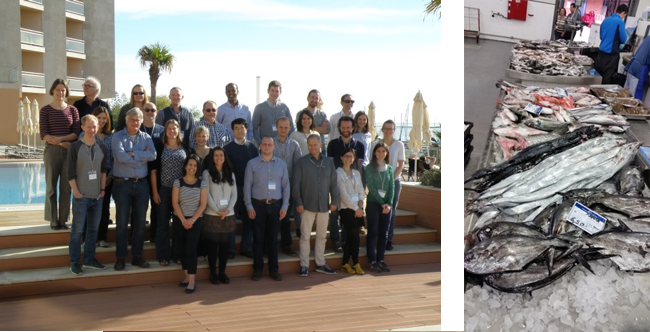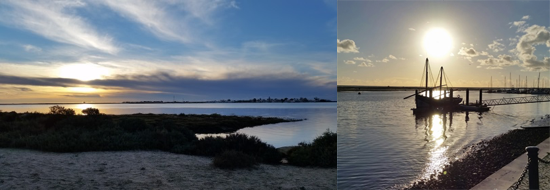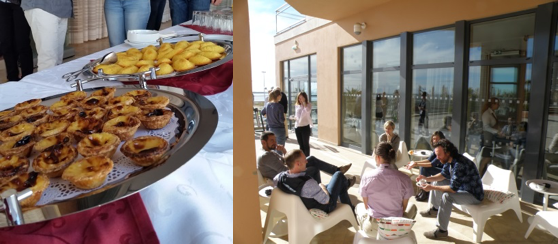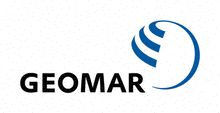Environmental baseline workshop
This November (22–25), a group of 28 STEMM-CCS scientists travelled to the beautiful town of Olhão, a few kilometres south of Faro in Portugal. The purpose of the trip was to participate in the Work Package 2 workshop; “Sampling design for baseline data acquisition”. The aim of the workshop was to discuss how environmental baseline surveys, suitable for geological Carbon dioxide Capture and Storage (CCS) projects, should be conducted.
 The workshop started with a review of the current approach to baseline data acquisition with particular attention paid to the availability of environmental data from the Goldeneye area; a potential storage site located off North East Scotland. Discussions and brainstorming followed, during which time we identified the key parameters that need to be measured as part of a CCS baseline survey. In the end we identified over 200 potential parameters which will now be assessed for relevance, feasibility and application to produce a definitive list of required data.
The workshop started with a review of the current approach to baseline data acquisition with particular attention paid to the availability of environmental data from the Goldeneye area; a potential storage site located off North East Scotland. Discussions and brainstorming followed, during which time we identified the key parameters that need to be measured as part of a CCS baseline survey. In the end we identified over 200 potential parameters which will now be assessed for relevance, feasibility and application to produce a definitive list of required data.
 Particular attention was paid to how such a baseline should deal with spatial and temporal variability in complex marine environments. These discussions prompted us to explore a variety of techniques including ecosystem modelling, remote sensing and the greater use of autonomous vehicles. The workshop represented a first step in producing a detailed plan for the collection of seasonally and spatially explicit data in support of an effective environmental baseline for the seabed (and overlying water column) over the Goldeneye storage complex, as an example of best practice.
Particular attention was paid to how such a baseline should deal with spatial and temporal variability in complex marine environments. These discussions prompted us to explore a variety of techniques including ecosystem modelling, remote sensing and the greater use of autonomous vehicles. The workshop represented a first step in producing a detailed plan for the collection of seasonally and spatially explicit data in support of an effective environmental baseline for the seabed (and overlying water column) over the Goldeneye storage complex, as an example of best practice.
 In addition to the hours of talks and discussions there was thankfully a little time for the workshop participants to enjoy the beautiful sites of Olhão and the surrounding area. The town sits on the world famous Ria Formosa and is home to an impressive variety of wading birds, including flamingos, storks, spoonbills, herons, grebes, egrets and many species of ducks and geese. All of these could be seen during an early morning or evening stroll to the nature reserve located to the south of the town or to the salt ponds to the north. Early in the morning was also a good time to see the spectacular bounty of fish and shellfish being sold at the local fish market. With access to such amazing ingredients it is not surprisingly that Olhão itself hosts a number of excellent restaurants and the food was amazing, especially the seafood. However, the biggest treat was at coffee break with the appearance of pasteis de nata, which are absolutely delicious little Portuguese custard tarts.
In addition to the hours of talks and discussions there was thankfully a little time for the workshop participants to enjoy the beautiful sites of Olhão and the surrounding area. The town sits on the world famous Ria Formosa and is home to an impressive variety of wading birds, including flamingos, storks, spoonbills, herons, grebes, egrets and many species of ducks and geese. All of these could be seen during an early morning or evening stroll to the nature reserve located to the south of the town or to the salt ponds to the north. Early in the morning was also a good time to see the spectacular bounty of fish and shellfish being sold at the local fish market. With access to such amazing ingredients it is not surprisingly that Olhão itself hosts a number of excellent restaurants and the food was amazing, especially the seafood. However, the biggest treat was at coffee break with the appearance of pasteis de nata, which are absolutely delicious little Portuguese custard tarts.





